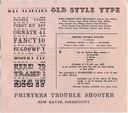{ Walters indicates that Harry Weidemann worked for Nuernberger-Rettig (and others) in Chicago. In the late 1940s and early 1950s he became involved in copying antique typefaces.
{ Hopkins, in the ATF Newsletter No. 7 } quotes two interesting letters which pertain the the beginning of Weidemann's independent typefounding. The first is a letter from Weidemann to Hopkins. It contains this passage, by Weidemann:
"I was the first to cast old-time types. My first face was Arboret, which I called Arboral. I picked all the letters out of a can of scrap at Republic of Chicago. I cleaned up the type and we shipped it to Williams Engineering in England to have the mats made. ..." (p. 7)
The second passage is from a letter from typefounder John S. Carroll to Hopkins. It confirms these details and gives more:
"Hell yes, he was way ahead of Charles Broad [Typefounders, Inc. [of Phoenix], and anybody else, for that matter. ...
"Harry Weidemann learned the typefounding trade in Chicago, and worked for a time with the Nuernberger-Rettig Co. ..."
"... then he moved back to Nyssa [Oregon] to care for his aged mother, and set up a type foundry there in his back yard, using a N-R Universal caster and getting his matrices made by Williams Engineering of England ... He put out the half-dozen or so ornate faces and sold quite a bit, back in the late 1940s, early 1950s." (p. 8)
{ Walters suggests that he may have electroformed his own matrices later. Certainly the ATF Newsletter article indicates that he was involved with electrotyping, at least.
His equipment in Nyssa included at least a Nuernberger-Rettig, more than one Thompson Typecaster, including one with a lead-and-rule attachment, and at one time a non-functional pivotal caster (sold before his death).
The information in { ATF Newsletter No. 7 } is unclear as to the disposition of Weidemann's matrices. The matrices for Arboral/Arboret, at least, probably went to Typefounders, Inc. [of Phoenix], long before Weidemann's death, because that foundry (Charles Broad) issued that face (although of course it is possible that Broad had new matrices of the same face electroformed for him). If these matrices went from Weidemann to Broad, they may have gone through John S. Carroll, who was both a friend of Weidemann's and the person who provided Charles Broad with his initial inventory of matrices copying "antique" faces.
Some of his matrices, however, must have accompanied him to his foundry in Nyssa, Oregon. As the Hopkins article relates, the materials of that foundry were destroyed by rapid auction upon Weidemann's death in 1981. Whether the matrices he then owned were preserved or not I do not yet know.

Printers Trouble Shooter (1958)
This is a 1958 advertisement from a new and used equipment dealer advertising five "antique" faces. Two of these are identified as Weidemann faces by McGrew. Given the date, it is not yet clear to me whether this type was cast by Weidemann or by Typefounders, Inc. [of Phoenix], but the face that one of the faces does not appear in later Phoenix or Los Angeles Type Founders literature suggests that indeed they may have been cast by Weidemann.
Hopkins, Richard L. Hopkins. "Death Claims Pioneer Private Typecaster; Shop Virtually Lost! Harry Weidemann." American Typecasting Fellowship Newsletter No. 7 (February, 1982): 6-10.
Walters, Gregory J. [communication on the Amalgamated Printers' Association e-mail list, 2011-03-06]
All portions of this document not noted otherwise are Copyright © 2011 by David M. MacMillan and Rollande Krandall.
Circuitous Root is a Registered Trademark of David M. MacMillan and Rollande Krandall.
This work is licensed under the Creative Commons "Attribution - ShareAlike" license. See http://creativecommons.org/licenses/by-sa/3.0/ for its terms.
Presented originally by Circuitous Root®
Select Resolution: 0 [other resolutions temporarily disabled due to lack of disk space]